NCERT Solutions for Chapter 10 Circles Class 10 Maths
Book Solutions1
Answer
A circle can have an infinite number of tangents.2
(i) A tangent to a circle intersects it in .......... point(s).
(ii) A line intersecting a circle in two points is called a .......... .
(iii) A circle can have .......... parallel tangents at the most.
(iv) The common point of a tangent to a circle and the circle is called .......... .
Answer
(i) exactly one(ii) secant
(iii) two
(iv) point of contact
3
(A) 12 cm
(B) 13 cm
(C) 8.5 cm
(D)√119 cm
Answer
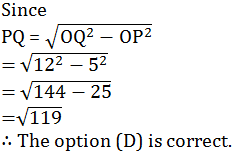
4
Answer
We have the required figure.Here, l is the given line and a circle with centre O is drawn.
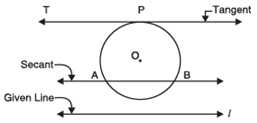
The line PT is drawn which is parallel to l and tangent to the circle.
Also, AB is drawn parallel to line l and is a secant to the circle.
1
From a point Q, the length of the tangent to a circle is 24 cm and the distance of Q from the centre is 25 cm. The radius of the circle is
(A) 7 cm
(B) 12 cm
(C) 15 cm
(D) 24.5 cm
Answer
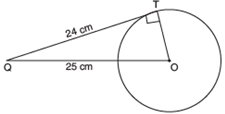
∵ QT is a tangent to the circle at T and OT is radius
Also, OQ = 25 cm and QT = 24 cm
∴ Using Pythagoras theorem, we get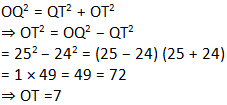
Thus, the required radius is 7 cm.
∴ The correct option is (A).
2
In figure, if TP and TQ are the two tangents to a circle with centre O so that ∠POQ = 110°, then ∠PTQ is equal to
(A) 60°
(B) 70°
(C) 80°
(D) 90°
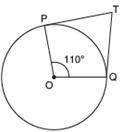
Answer
∵ TQ and TP are tangents to a circle with centre O. such that ∠ POQ = 110°∴ OP ⊥ PT and OQ ⊥ QT
⇒ ∠OPT = 90° and ∠OQT = 90°
Now, in the quadrilateral TPOQ, we get
∴∠PTQ + 90° + 110° + 90° = 360°
⇒ ∠PTQ + 290° = 360°
⇒∠PTQ = 360° − 290° = 70°
Thus, the correct option is (B)
3
If tangents PA and PB from a point P to a circle with centre O are inclined to each other at angle of 80°, then ∠POA is equal to
(A) 50°
(B) 60°
(C) 70°
(D) 80°
Answer
Since, O is the centre of the circle and two tangents from P to the circle are PA and PB.∴ OA ⊥ AP and OB ⊥ BP
⇒ ∠OAP = ∠OBP = 90°
Now, in quadrilateral PAOB,
we have: ∠APB + ∠PAO + ∠AOB + ∠PBO = 360°
⇒ 80° + 90° + ∠AOB + 90° = 360°
⇒ 260° + ∠AOB = 360°
⇒∠AOB = 360° − 260°
⇒∠AOB = 100°.
In rt Δ OAP and rt Δ OBP, we have
OP = OP [Common]
∠OAP = ∠OBP [Each = 90°]
OA = OB [Radii of the same circle]
∴ Δ OAP ≅ Δ OBP
∴ Their corresponding parts are equal
⇒ ∠POA = ∠POB

4
Answer
In the figure, we have:PQ is diameter of the given circle and O is its centre.
Let tangents AB and CD be drawn at the end points of the diameter PQ.
Since the tangent at a point to a circle is perpendicular to the radius through the point.
∴ PQ ⊥ AB ⇒∠APQ = 90°

And PQ ⊥ CD
⇒ ∠PQD = 90°
⇒ ∠APQ = ∠PQD
But they form a pair of alternate angles.
∴ AB ║ CD.
5
Answer
In the figure, the centre of the circle is O and tangent AB touches the circle at P.
If possible, let PQ be perpendicular to AB such that it is not passing through O.
Join OP.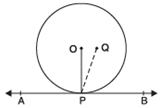
Since tangent at a point to a circle is perpendicular to the radius through that point,
∴ AB ⊥ OP i.e. ∠OPB = 90° ...(1)
But by construction, AB ⊥ PQ
⇒ ∠QPB = 90° ...(2)
From (1) and (2),
∠QPB = ∠OPB
which is possible only when O and Q coincide.
Thus, the perpendicular at the point of contact to the tangent passes through the centre.
6
Answer
The tangent to a circle is perpendicular to the radius through the point of contact.∴∠OTA = 90°
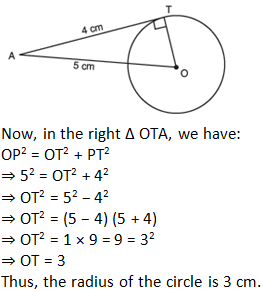
7
Answer
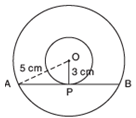
In the figure, O is the common centre, of the given concentric circles.
AB is a chord of the bigger circle such that it is a tangent to the smaller circle at P.
Since OP is the radius of the smaller circle through P, the point of contact,
∴ OP ⊥ AB
⇒ ∠APB = 90°
Also, a radius perpendicular to a chord bisects the chord.
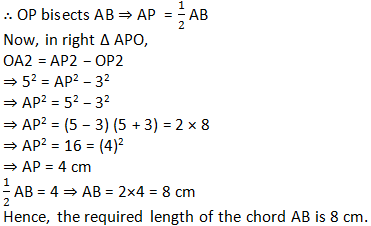
8
AB + CD = AD + BC
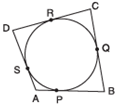
Answer
Since the sides of quadrilateral ABCD, i.e., AB, BC, CD and DA touch the circle at P, Q, R and S respectively, and the lengths of two tangents to a circle from an external point are equal.∴ AP = AS
BP = BQ
DR = DS
CR = CQ
Adding them, we get (AP + BP) + (CR + RD) = (BQ + QC) + (DS + SA)
⇒ AB + CD = BC + DA
Hence, proved.
9
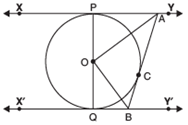
Answer
∵ The tangents drawn to a circle from an external point are equal.∴ AP = AC
In Δ PAO and Δ AOC, we have :
AO = AO [Common]
OP = OC [Radii of the same circle]
AP = AC
⇒ ∆ PAO ≅∆ AOC [SSS Congruency]
∴∠PAO = ∠CAO
∠PAC =2 ∠CAO ..(1)
Similarly ∠CBQ = 2 ∠CBO ...(2)
Again, we know that sum of internal angles on the same side of a transversal is 180°.
∴∠PAC + ∠CBQ = 180°
⇒ 2 ∠CAO + 2 ∠CBO = 180° [From (1) and (2)]
Also ∠CAO + ∠CBO + ∠AOB = 180° [Sum of angles of a triangle]
⇒ 90° + ∠AOB = 180°
⇒ ∠AOB = 180° − 90°
⇒ ∠AOB = 90°.
10
Answer
Here, let PA and PB be two tangents drawn from an external point P to a circle with centre O.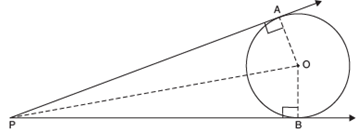
Now, in right ∆ OAP and right ∆ OBP, we have
PA = PB [Tangents to circle from an external point P]
OA = OB [Radii of the same circle]
OP = OP [Common]
∴ By SSS congruency,
∆ OAP ≅∆ OBP
∴ Their corresponding parts are equal.
∴∠OAA = ∠OPB
And ∠AOP = ∠BOP
⇒∠APB = 2 ∠OPA and ∠AOB = 2 ∠AOP
But ∠AOP = 90° − ∠OPA
2 ∠AOP = 180° − 2 ∠OPA
⇒∠AOB = 180° − ∠APB
⇒∠ AOB + ∠APB = 180°.
11
Answer
We have ABCD, a parallelogram which circumscribes a circle (i.e., its sides touch the circle) with centre O.Since tangents to a circle from an external point are equal in length,
∴ AP = AS
BP = BQ
CR = CQ
DR = DS
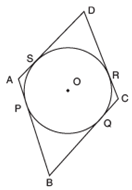
Adding, we get
(AP + BP) + (CR + DR) = (AS + DS) + (BQ + CQ)
⇒ AB + CD = AD + BC
But AB = CD[opposite sides of ABCD]
and BC = AD
∴ AB + CD = AD + BC
⇒ 2 AB = 2 BC
⇒ AB = BC
Similarly AB = DA and DA = CD
Thus, AB = BC = CD = AD
Hence ABCD is a rhombus.
12
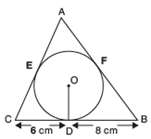
Answer
Here, Δ ABC subscribe the circle with centre O.Also, radius = 4 cm
∵ The sides BC, CA and AB touch the circle at D, E and F respectively.
∴ BF = BD = 8 cm
CE = CD = 6 cm
AF = AE = x cm (say)
⇒ The sides of the triangle are:
14 cm, (x + 6) cm and (x + 8) cm
Perimeter of Δ ABC
= [14 + (x + 6) + (x + 8)] cm
= [14 + 6 + 8 + 2x] cm
= 28 + 2x cm
⇒ Semi perimeter of Δ ABC

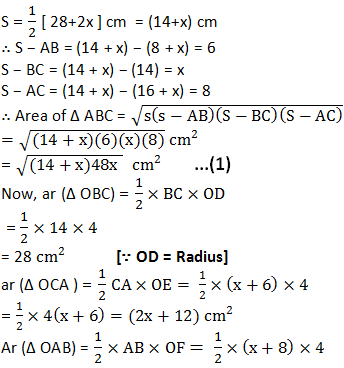
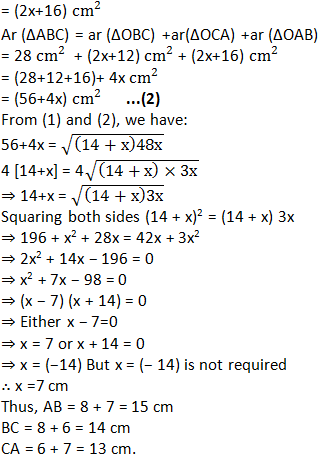
13
Answer
We have a circle with centre O.
A quadrilateral ABCD is such that the sides AB, BC, CD and DA touch the circle at P, Q, R and S respectively.
Let us join OP, OQ, OR and OS. We know that two tangents drawn from an external point to a circle subtend equal angles at the centre.
∴∠1= ∠2
∠3 = ∠4
∠5= ∠6 and ∠7 = ∠8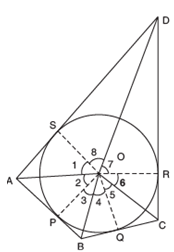
Also, the sum of all the angles around a point is 360°.
∴ ∠1 + ∠2 + ∠3 + ∠4 + ∠5 + ∠6 + ∠7 + ∠8 = 360°
∴ 2 [∠1 + ∠8 + ∠5 + ∠4] = 360°
⇒ (∠1 + ∠8 + ∠5 + ∠4) = 180° ..(1)
And 2 [∠2 + ∠3 + ∠6 + ∠7] = 360°
⇒ (∠2 + ∠3) + (∠6 + ∠7) = 180° ...(2)
Since, ∠2 + ∠3 = ∠AOB
∠6 + ∠7= ∠COD
∠1 + ∠8= ∠AOD
∠4 + ∠5= ∠BOC
∴ From (1) and (2), we have:
∠AOD + ∠BOC = 180° and
∠AOB + ∠COD = 180°